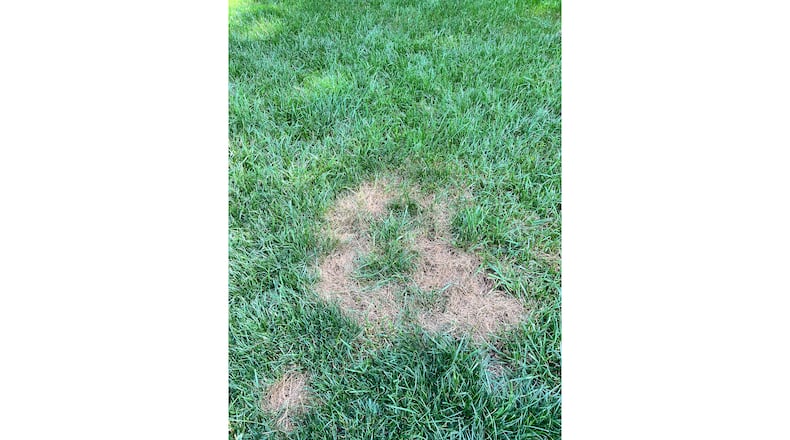Q: We are having a hard time with our fescue lawn. We use 12-4-8 fertilizer four times a year but no preemergent or postemergent weed control. We aim for 1 inch of water per week, watering about one hour daily. It is green and lush, but there are occasional spots where the grass turns brown and then expands into a perfect circle. Sometimes green grass grows in the center of the circle. We don’t want to lose this beautiful fescue! Jennifer Sifuentes, email
A: Sounds like you’ve done a pretty good job with your lawn. I think the problem lies with your watering. It’s good to aim for 1 inch of water per week, but it should be applied all in one day, allowing the soil to dry for six days between waterings. The circular spots are probably caused by large patch disease (formerly brown patch), which I often see in lush lawns like yours. Proper watering helps fight disease by keeping plant leaves dry as much as possible. Changing your watering may be all that’s needed to manage the disease, but applying a lawn fungicide to stop its spread will help.
Q: Have you ever tried ollas in your vegetable gardens? This is my second year using them, and I rarely have to supplement their water. Watering is more consistent this way. Julie McCraney, email
A: Ollas are small earthenware pots with a large body and a small neck. They are buried in the garden with the body below ground and the neck sticking up above the soil. The material they’re made of, typically unfired clay, allows water to seep out through the walls, thus watering the plants nearby. I have not used them but they look like fun. The only problem I foresee is you can’t fertilize with them, because fertilizer would clog up the pores in the walls.
Q: I have tomato plants that are blooming and it looks like something is cutting the stems just below the blossoms. Please advise your thoughts. Emma Wilson, email
A: Are you sure something cut the flower off? When nighttime temperatures are in the 70s and daytime temperatures are in the 80s to 90s, tomatoes naturally drop some flowers. This is due to the pollen becoming sticky so it cannot travel between the male anther and the female stigma. Sensing that pollination has not occurred, the flower petals dry up and fall off. You can help pollination along by using a pencil-sized stick and tapping flower clusters lightly each day after they open until a tomato forms and swells. If you have an old electric toothbrush, you can walk down your tomato row and give each cluster of flowers a short buzz. Here’s a bonus: Tapping results in better pollination than the breezes that help pollinate a tomato. You may get bigger tomatoes that result from tapping.
Email Walter at georgiagardener@yahoo.com. Listen to his occasional garden comments on “Green and Growing with Ashley Frasca” Saturday mornings on 95.5 WSB. Visit his website, walterreeves.com, or join his Facebook page at bit.ly/georgiagardener for his latest tips.
About the Author
Keep Reading
The Latest
Featured


